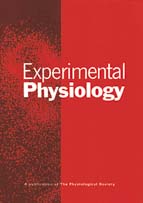Article contents
Stimulation of ventilation by normobaric hyperoxia in exercising dogs
Published online by Cambridge University Press: 10 January 2001
Abstract
In order to describe the factors which, during hyperoxic exercise, can counteract the chemoreceptor-mediated inhibition of ventilation by O2, minute ventilation (VE) and the pulmonary gas exchange were studied breath-by-breath in four dogs running on a treadmill (5 km h-1) for 10 min during and following exposure to O2 of different durations. We found that a brief inhalation of O2 applied during the steady state of the VE response provoked a reduction in VE by 6.5 ± 0.9 l min-1 whereas hyperoxia applied 2 min before the onset of exercise and maintained for 2.5 min during the running tests had a significantly weaker effect on VE (-1.8 ± 0.2 l min-1, P < 0.05). The rise in pulmonary CO2 output (VCO2) during the prolonged O2 exposure was less than in normoxic exercise leading to a deficit of CO2 eliminated by the lungs of 181 ml. The return to air breathing provoked a rise in VE, which reached within 73 s a much higher level than the control tests (22.9 ± 3.6 vs. 19.5 ± 2.2 l min-1, P < 0.05); VE then subsided to control levels with a long exponential decline. The CO2 deficit during O2 breathing, was fully compensated after recovery in air within 6 min. No stimulatory effect on ventilation was observed at rest at the cessation of a similar exposure to O2 despite a higher end-tidal PCO2 (+4 ± 1 mmHg) than in exercise. In conclusion, the stimulatory effect of O2 during exercise can be clearly revealed after recovery in air and seems to operate through a more complex mechanism than that thought to be involved at rest. We propose that the changes in CO2 stores in the exercising muscles could contribute to O2-induced stimulation during exercise, possibly through stimulation of muscle afferents responding to local circulatory changes. Finally, the observation that during continuous dopamine (DA) infusion (5 µg kg-1 min-1) the VE response to recovery in air was only a slow decrease, suggests that the arterial chemoreceptors potentiate O2-induced hyperventilation, or that the vascular actions of DA counteract part of the effects provoked by CO2 accumulation in the exercising muscles.
- Type
- Research Article
- Information
- Copyright
- © The Physiological Society 2000
- 6
- Cited by


